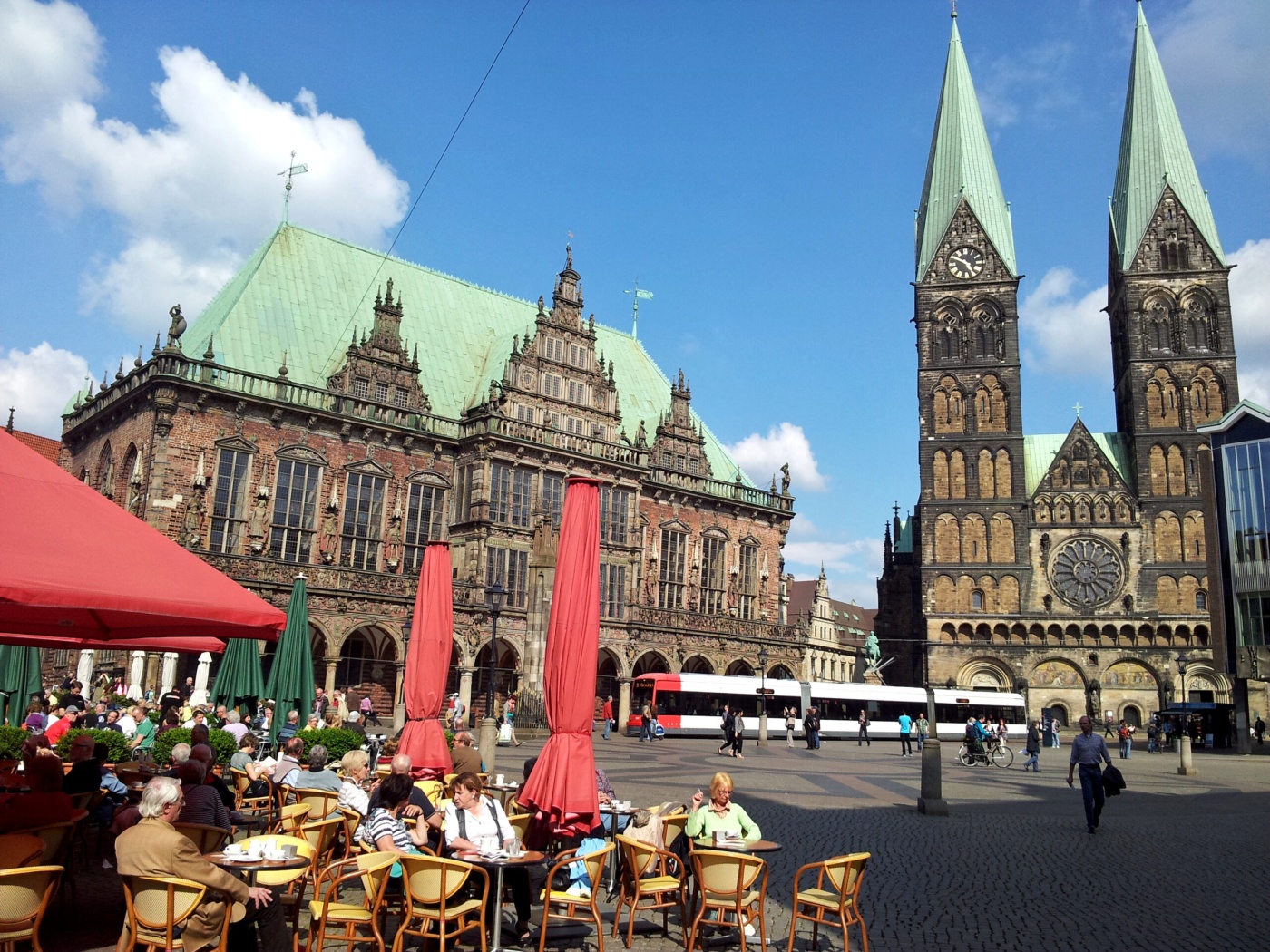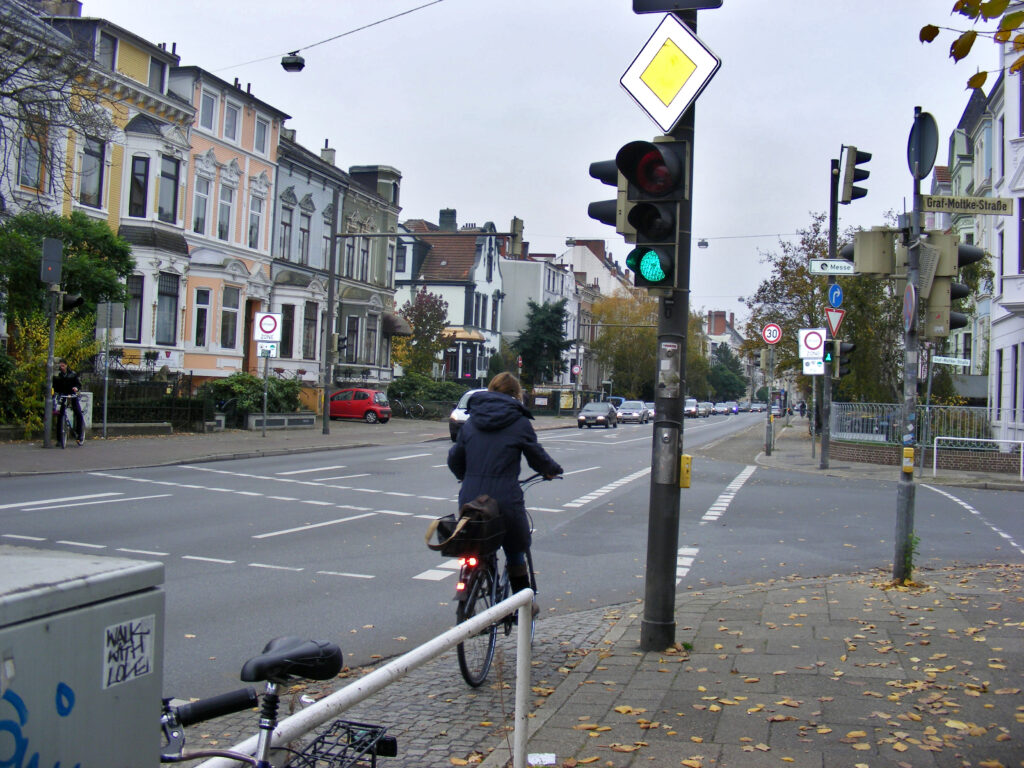This website uses cookies so that we can provide you with the best user experience possible. Cookie information is stored in your browser and performs functions such as recognising you when you return to our website and helping our team to understand which sections of the website you find most interesting and useful.
Bremen – a city that plays the BLUES for the people and with the people

The Bremen “Umweltzone”, or Low Emission Zone, one of the smallest among such zones in Germany, has only 7 square kilometers. In spite of this, Bremen enjoys the lowest NO2 pollution levels in big German cities. It also boasts the highest share of cycling in transport and a comparatively high average speed of road traffic. How is it possible? These are the effects of a decades-long, consistent and systemic policy by the City of Bremen – a policy of which the LEZ is only a part, and which is aimed at improving the well-being of the inhabitants of the city.
Bremen is called “the bike city”, and for good reason – one fourth of traffic there is generated by cyclists. They have significantly more than 700 km of bike roads and lanes provided by the city at their disposal, including ones that run through parks and other greenery. Moreover, on one way streets, cyclist can also ride the “wrong” way, while the Blockland district (one of the biggest in Bremen, situated on its outskirts) has made all of its streets available to pedestrian and bike traffic – and only the inhabitants of this district can drive cars there. To take advantage of these and many other bike-friendly solutions available in Bremen, one does not have to own a bike – many cheap and convenient rental schemes work in the city, e.g. WK-Bike or Fietje (for cargo bikes which can be used to transport both people and goods).
How did the people of Bremen come to love bikes so much? Were bikes the miracle cure for air pollution? Today’s picture of the city is a result of consistent, decades-long efforts in accordance with the principle of “use anything but private cars”. Bremen has gone through a long and complicated process – the fact that today bikes or the small Low Emission Zone catch the eye should not obscure the full picture.
– Complex planning, including spatial planning, is the best way to restrict not only emissions, but other burdens and dangers resulting from road traffic as well. It is also a method applicable to the urban mobility system as a whole: for improving its efficiency and decreasing its susceptibility to changing prices of fuels and electricity – emphasizes Michael Glotz-Richter, Senior Project Manager for Sustainable Mobility at the Bremen City Hall. At the same time, the systemic nature of the tools applied does not mean that all of them have to be complicated – to the contrary: some of the mobility solutions used in Bremen are remarkably simple (and work to great effect). Priority in traffic for city busses and trams is one such mechanism.
The Sustainable Urban Mobility Plan for Bremen 2025 (English version) – the so-called VEP 2025 (German version) – which addresses all means of transport and movement in the city, proposes further bike-friendly solutions, such as premium bike lanes, which are intended to facilitate fast, convenient, and safe cycling through the city, particularly over longer distances. Works on this plan started 13 years in advance, and it came into force 11 years before the date in its title. Obviously, it was thoroughly consulted with the inhabitants of Bremen. What is more, in 2018 the VEP 2025 was expanded with the so-called Green City Master Plan (in German), containing a further more than 80 actions grouped in 4 areas that were deemed the most important for the future of transport at the time (innovative road traffic planning – including car sharing and non-motorized traffic, digitization of the traffic system, automation of driving, and changes brought about by alternative means of propulsion and fuels). The manner in which these plans were prepared is a perfect case study for all local governments – a great source of knowledge and tools for improving the air quality in a city, or rather for changing a whole city for the better. It is also an example which clearly shows that city policy cannot be something that is shaped on an ad hoc, day-to-day basis. What are the effects of such an approach? Let us see the statistics: in 2018, there were… 2 bikes for each household in Bremen and 0.9 of a car. A third of households did not have a car at all.

(photo: Ulamm on Wikipedia.org – on license, after graphic edits)
Did a city offering such conditions really need a Low Emission Zone, and such a small one at that? This is clearly a trick question, because what Bremen did first, was to provide its inhabitants “such conditions”, which is why its LEZ did not surprise anyone like a bolt out of the blue, nor did it need to be bigger. It plays exactly the role that is intended for a Low Emission Zone. “The main goal of the LEZ is to restrict the emission of harmful substances from engine-powered vehicles, particularly vehicles with Diesel engines. The most important source of the pollutions in question is road traffic which is responsible for ca. 30 percent of particulate matter and 60 percent of nitrogen dioxide in the air within the Zone” – one can read, in loose translation, on the city’s website. – We have created the LEZ to improve the air quality in the city and protect the health of inhabitants – sums up Michael Glotz-Richter.

(photo: Michael Glotz-Richter)
Small but effective
The area covered by the Bremen LEZ is inhabited by ca. 65 000 people – a little over 10 percent of the city’s total population. With as little as 7 square kilometers (the total size of Bremen is over 320 square kilometers), it is not only the smallest Zone in the biggest German cities, but also one of the smallest in Germany as a whole (a Zone of same size exists in Ulm – a city with ca. a third of Bremen’s area and a fifth of its population).
The Zone started its operations in January 2009, but the origins of its story can be traced back to the previous century – specifically to 1987, when the BLUES started “playing”. BLUES is Bremen’s air quality control system (the acronym stands for the German term “das Bremer Luftüberwachungssystem”). The system comprises 9 stations that measure among others the concentration of particulate matter and nitrogen dioxide, both in Bremen and in the neighboring Bremerhaven, six of which monitor specific sites (the most crowded roads) and three monitor the traffic itself. The website of the city has a subsection where the measurements of the BLUES are posted in the form of a simple air quality indicator, updated every hour and understandable for everyone, as it is based on the German school grade system of 1 to 6, where 1 is the best grade and 6 – the worst.
In the establishing the Low Emission Zone, Bremen has also acted well in advance. The City Hall gave itself the time it needed: necessary analyses (in German) were done in 2005, while the resolution on the creation of the LEZ – in August 2008, almost 2.5 years before the “opening day”. The upsides of such an approach are obvious – each interested party and group affected by the LEZ was provided with comfortable conditions to prepare for it. The City Hall had time to educate, communicate and consult, as well as to amend and expand the draft of the resolution, while the inhabitants, local communities and entrepreneurs could learn more, get thoroughly acquainted with the topic, actively participate in the elaboration of the resolution, and undertake all appropriate individual actions, such as leasing or buying cars (more on that below).
The control system in the Bremen LEZ, similarly to other “Umweltzones” in German cities, is based on the so-called environment plaques – there are 3 kinds of them: red, yellow, and green (the classification is based among others on Euro norms). Those who enter the Zone in Bremen without the proper plaque risk a fine of 100 euro (for comparison: a monthly ticket for public transport costs a little less than 68 euro).
The Bremen Low Emissions Zone was introduced in 3 stages. In the first phase, all cars with plaques – regardless of their color – could enter which meant that the Zone was accessible for petrol-powered vehicles with a catalytic converter and Diesel-powered vehicles which met the Euro 2 norm or higher. The next stage started a year later – from then on, only vehicles with yellow or green plaques could enter, while the final step was made 2 years after that – specifically in July 2011. Since then, only vehicles with a green plaque can enter the Zone: e.g. Diesel vehicles which meet the Euro 4 norm or higher.

(photo: Michael Glotz-Richter)
Not only the Zone…
When introducing its LEZ, Bremen has simultaneously conducted many other activities, resulting both from the city’s strategy and from the awareness of the need for other facilitating solutions. – These activities included programs for financing less polluting ways and means of transport – not only public transport – as well as low emission vehicles. For example, the city ensured that all new busses met the EEV norm, the highest possible. Of course, all of this applies to the factual and technical state at the time, in the years 2007-2012 – explains Michael Glotz-Richter.
The expert of the Bremen City Hall also points to the “PARFUM” project, financed by the EU’s LIFE program, which addressed the impact of cargo and passenger transport on urban air quality. The project elaborated technological innovations and environmental policies aimed at restricting the emission of air pollutants caused by road traffic – such as the previously mentioned traffic light priority for public transport. The effects it brought in Bremen – and it brought plenty – are discussed in detail in this video (in English).
In 1998 – let us emphasize that: 25 years ago – as an alternative to private cars, Bremen promoted car sharing services, initially as part of a package with an integrated public transport ticket connecting the right to use public transport with the possibility of renting a car. Five years later, the so-called mobility stations appeared on Bremen’s streets, where cars can be rented directly in the neighborhoods where people live and work. Today, in central Bremen, one can find such a station roughly every 300 meters. – In 2013, we integrated this system with new residential buildings – first it was optional, voluntary, but from last year it is mandatory for developers – says the expert of the Bremen City Hall. – Car sharing is a key element of urban development, new buildings and managing the district streets. Working with the motto of ‘use – do not own’ gives us not only more space for people, but also savings in residential buildings. Sharing cars is a big win for cities. For Bremen it is also a specific number – without the municipal car sharing system, ca. 8 000 more passenger cars would drive on our streets – emphasizes Michael Glotz-Richter.

(photo: Michael Glotz-Richter)
“Nothing about us without us” – in Bremen too
The Low Emission Zone in Bremen is a good example of cooperation with the people who will be impacted by the consequences of a given action. The introduction of the LEZ was preceded in Bremen by a thorough awareness campaign and social consultations. The City has recorded as many as 154 suggestions and objections (protocols and replies, including illustrative materials – presentations, reports, summaries – are still available at the city’s website). The Zone was discussed not only with private citizens, but also with companies working in it and in close proximity to it (!), with business associations and chambers of commerce, including transport associations and companies, environmental organizations, as well as with representatives of city administration – the City Hall itself and municipal companies. The suggestions that Bremen took into account included e.g. a motion to establish an exemption to LEZ regulations for motorhomes owned by the inhabitants of the Zone. A flagship example of taking local conditions for business into consideration was the so-called “Fleet Agreement”. There were ca. 5 000 crafts companies in Bremen, with a total of ca. 15 000 vehicles at their disposal – some of them had a very low annual mileage, because they served as mobile workshops and remained practically in a single location. – In order to facilitate their functioning we agreed with the crafts chamber exemptions for trucks and delivery vehicles for entrepreneurs in Bremen. This contract included a special agreement with entities who had large vehicle fleets – in exchange for prolonging the right to enter the Zone for trucks and delivery vans which met the Euro 3 norm, these entities have agreed to then change their cars straight to Euro 5, skipping Euro 4 – this was a good and reasonable agreement, and has greatly contributed to restricting the levels of nitrogen oxides in the air in Bremen – explainsMichael Glotz-Richter and adds that the Fleet Agreement has met with recognition not only in the city itself but also – thanks to media coverage – all over Germany.
The Low Emission Zone in Bremen brought the predicted and expected results after 7 years. – Since 2016, we have consistently fit under the threshold values for air quality indicators with regards to the concentration of both PM10 particles and nitrogen dioxide – says Glotz-Richter with satisfaction. Moreover, Bremen plans to be climate neutral by 2038.
(illustration photo: Michael Glotz-Richter)
